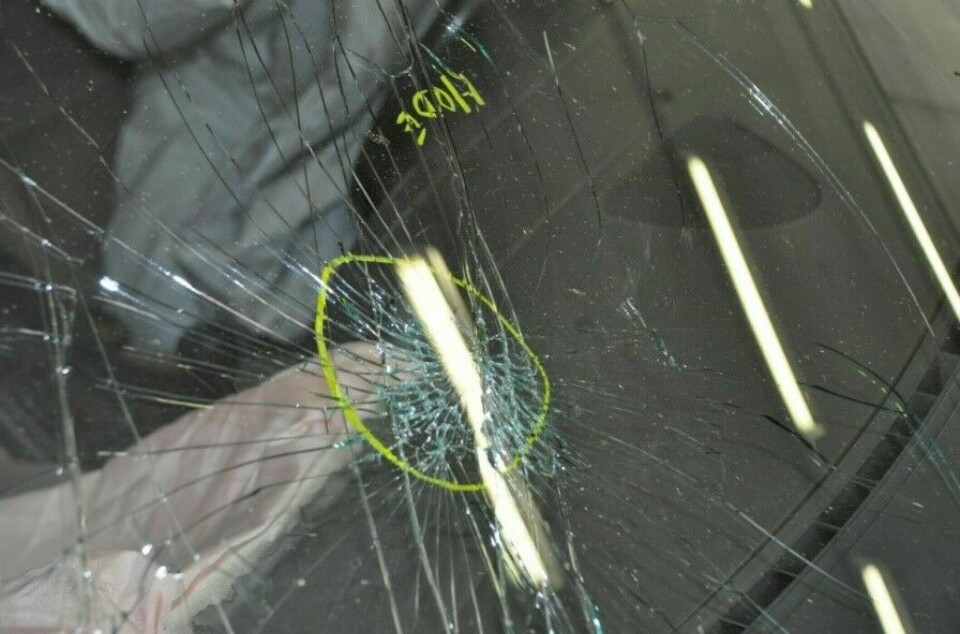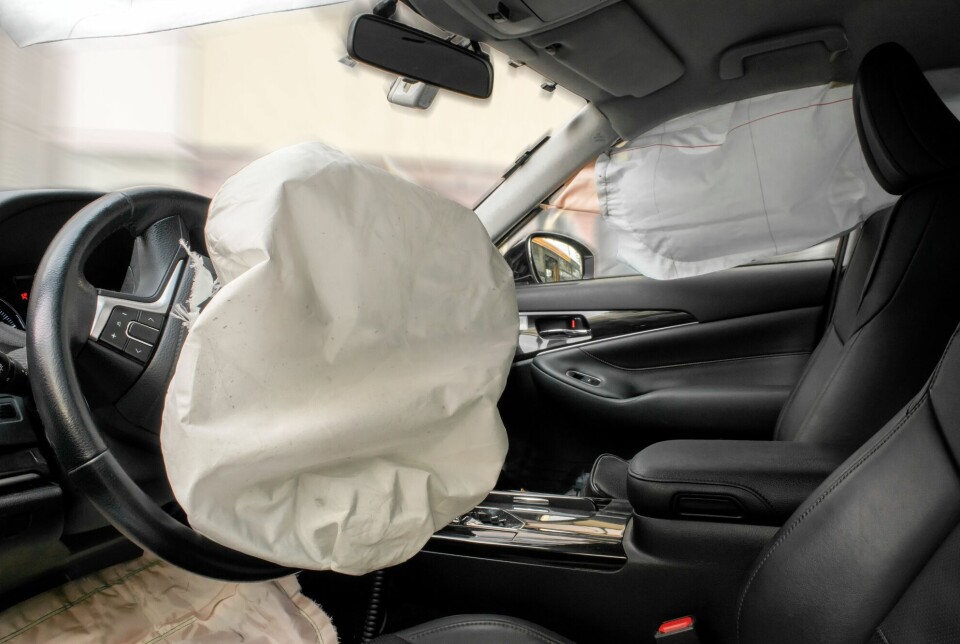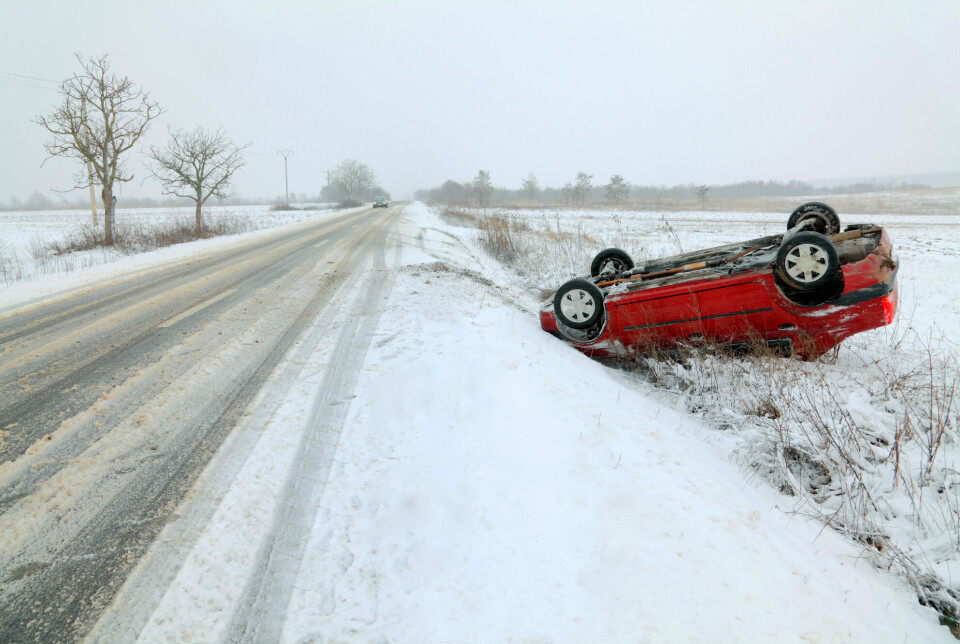
Researchers found something surprising when deceased drivers were autopsied
Norwegian men have heart attacks more often than was known and die a natural death behind the wheel. And a fairly large proportion of drivers in fatal collisions have likely taken their own lives.
Chief physician Jan Mario Breen has looked at all autopsied deaths after traffic accidents in Southeast Norway over the past several years.
“We found that a whole 70 per cent of drivers older than 55, who were at fault in collisions, had narrow coronary arteries, signs of old heart attacks or brain infarctions, or other changes in the brain,” he says.
Many of the drivers with these pre-existing health conditions may have suffered a sudden acute incident – and died from this – while they were behind the wheel.
“This usually concerns older men,” Breen tells sciencenorway.no.
He has studied these deaths in his doctoral thesis at the University of Oslo's Faculty of Medicine.
Managed to step on the brake
A large proportion of the deceased drivers Breen studied had managed to step on the brake.
The driver was often able to slow down before the accident occurred. In these cases, the deceased had no accident-related injuries that could explain the cause of death.
“We found that among the drivers who caused a collision in which they died, the direct cause of death in 12 per cent of the cases was medical illness,” says Breen.

Some were unable to slow down
“But then you have people
who are unable to slow down and who collide with another vehicle at high speed,” Breen says.
Most viewed
No content
If a car collides with another vehicle, it can be particularly difficult to definitively determine the cause of the driver’s death. This is especially a problem if those performing the autopsy find the driver had medical problems in addition to fatal injuries.
"Our findings indicate that in up to 16 per cent of cases where drivers were at fault for the collision and died from their injuries, a medical condition might have played a role in leading up to the accident," he says.
Breen thinks this is absolutely something to be aware of when considering serious traffic accidents.
Drivers are still dying
There has been a significant decrease in the number of fatalities and severe injuries in traffic in Norway in recent decades.
- Pedestrians die far less often than before.
- Among the youngest children, an average of one child now dies in traffic each year.
- Among children and youth from 5 to 15 years old, the number that are severely injured and killed has been halved since 2000.
Going back to 1970, 560 people died on Norwegian roads. Now, there may be years in which fewer than 100 people die in traffic accidents.
These statistics are even more surprising when you consider that there are three times as many cars on the roads in Norway now as in 1970.
And that accidents involving motorcycles and mopeds now account for around 20 per cent of all fatalities. Electric scooters and ATVs have also contributed to the tally of fatal accidents.

Nevertheless, the number of traffic fatalities has drastically decreased. However, one group that has not experienced this same decrease in deaths is drivers themselves.
But why?
Investigated all fatal accidents
As part of his research, Jan Mario Breen has compiled research from a total of four different studies on motor vehicle collisions in Norway.
His doctorate is the result of collaboration between forensic pathologists, trauma surgeons, and the accident investigators at Oslo University Hospital.
Forensic pathologists are experts in investigating the causes of sudden death. They perform autopsies and look for injuries or diseases that may be the true cause of a death.
For three years, a separate team of accident investigators went out to examine the vehicles.
They spoke to survivors of the accidents, relatives, police, health personnel, and investigators from the Norwegian Public Roads Administration.
10 per cent may be suicides
Deaths in traffic in which the driver has deliberately caused the accident have been underreported for many years.
But determining whether the accident involves suicide behind the wheel can only be done if all the circumstances of the incident are clarified.
A forensic autopsy must also be carried out.
Breen and his colleagues now believe that up to 10 per cent of driver fatalities in Norway might be suicides.
They determined this by comparing findings from autopsies from 2000-2014, with investigations carried out after accidents by the Norwegian Public Roads Administration.

Surprisingly high number
“This number may seem surprisingly high. But similar figures have also recently been found by researchers in Sweden,” Breen says.
“Often, this involves passenger cars that collide head-on with large vehicles on straight stretches. About a third of these drivers were under the influence of medications or drugs, the most common being alcohol,” he says.
These drivers also frequently had traces of medication for depression in their blood, and a health history of previous or current mental health problems, according to Breen.
“For some reason, there was also a clear excess of such deaths in the spring,” he says.
Breen adds that the researchers also know of cases where fatalities that were clearly accidents have been misclassified as suicides. It goes without saying that it is of great importance for relatives to be certain of the cause of death, the researcher points out.
Young people die behind the wheel
A third and even larger group who are injured or die behind the wheel are young people aged 16-24.
These young adults account for less than 10 per cent of the traffic on the roads. But they make up about 25 per cent of all those killed in car accidents.
Breen and his colleagues had the opportunity to examine all car accidents in Southeast Norway where young people between the ages of 16 and 24 were seriously or life-threateningly injured.
“Young drivers who were seriously injured or killed were themselves responsible for the accident in 90 per cent of the cases we looked at,” Breen says.
75 per cent of these were young men.

When drivers under the age of 24 are involved in fatal accidents or other serious accidents, the researchers found that high speed was a factor in as many as 80 per cent of the cases.
They found that the driver was under the influence of drugs in 27 per cent of the cases.
And 35 per cent of these accidents happened at night.
Accidents with young people behind the wheel typically do not happen on motorways. Nor do they happen on low-speed roads in urban areas. Instead, they often occur on non-urban roads with speed limits of over 70 kilometres per hour, without a traffic median.
One pattern that became clear during the analysis was that the drivers were in old cars when they were speeding.
No technical faults on the car
Breen and his colleagues have not only taken a closer look at autopsies of traffic fatalities.
They have also examined the accident sites. And they have inspected the vehicles that were involved, both inside the car and externally. In addition, the researchers have reviewed accident reports from the police and other authorities.

Technical faults in vehicles are rarely the cause of fatal accidents in Norway, the researchers conclude.
Generally, the fault lies with the driver. And it is often related to speed, carelessness, and the influence of drugs.
And a significant proportion of the deaths are related to natural death or suicide.
Leaned far back in the driver's seat
Among those who died in car collisions in Norway between 2000 and 2014, only half were wearing seat belts, the researchers note.
It is usually men who do not wear seat belts.
When young people under the age of 24 die or are seriously injured in a car accident, the researchers found that around 60 per cent of the injured or killed drivers and passengers could have reduced the extent of their injuries.
And even when young people were wearing seat belts, they often ended up in the wrong position.
The seat belt might have been under the left arm of the deceased driver. Or behind their back. This was mostly true for young women, the researchers discovered.
“Many of the drivers who died were also sitting with their seatbacks tilted far back,” Breen says.
This meant that the seat belt didn’t tighten properly when the car collided.
93 per cent of the children were secured incorrectly
The researchers clearly see how deaths and serious injuries can be largely prevented in the event of a serious car accident.
Proper use of seat belts and securing both children and adults now saves many lives every year. This is an important reason why so few children and young people under the age of 16 die in traffic.
As many as 93 per cent of the children who were seriously injured in cars in Southeast Norway during the period 2009-2013 had been secured incorrectly.
The researchers found that either the seat belt had been put on the child incorrectly, or the child was injured by heavy luggage in the car.
The most common error was that the child had the chest portion of the seat belt under an arm or behind their back.
Autopsies now required
Breen thinks it is important that traffic fatalities in Norway be autopsied.
Previously, only around half of all traffic fatalities were autopsied. A change in the law in 2020 introduced mandatory autopsies for all traffic fatalities.
“This helps us to uncover the actual cause of death and gain better knowledge about the events and about the reason behind a traffic accident. This is the only way we can find out whether a fatal traffic collision was an accident, a natural death, or a suicide,” he says.
Research based on autopsies and investigation of traffic accidents can also provide us with valuable knowledge about how to prevent traffic accidents, the researchers believe.
References:
Amundsen, A.H. Barn og ungdom i traffiken (Children and young people in traffic), Institute of Transport Economics report, 2018.
Breen, J.M. Fatalities and severely injured occupants in motor vehicle collisions – the causation, injury mechanisms and the significance of safety measures, Doctoral thesis at the University of Oslo, 2022/2023.
Statistics Norway: Flere omkomne I trafikken I 2022 (More traffic fatalities in 2022), 2023.
The Norwegian Public Roads Administration: Dybdeanalyser av dødsulikker I vegtrafikken 2019 (In-depth analyses of fatal accidents in road traffic 2019), 2020.
———
Translated by Nancy Bazilchuk
Read the Norwegian version of this article at forskning.no


































